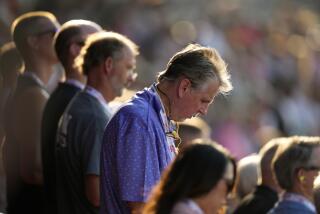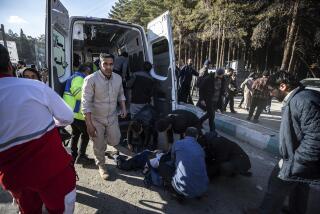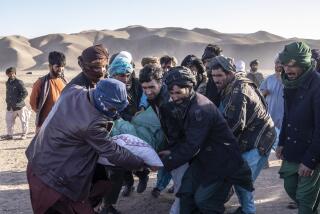Gunman Tries to Assassinate Afghan Leader
- Share via
KABUL, Afghanistan — A gunman tried unsuccessfully to kill President Hamid Karzai on Thursday and was shot to death by the Afghan leader’s U.S. military bodyguards, just hours after two explosions in a crowded downtown Kabul market area killed at least 24 people.
Officials said they did not know whether the assassination attempt in the southern city of Kandahar and the explosions here in the capital were related. The violence shattered a fragile calm that had prevailed here in recent weeks, and came just ahead of the one-year anniversary of the Sept. 11 terrorist attacks.
Kandahar’s governor and an American bodyguard were wounded in the shooting, though neither seriously, while three people were killed. Karzai was unhurt, and later flew to Kabul on a U.S. aircraft.
The would-be assassin was identified today by government officials at the scene as Abdul Rahman of the Kajaki district in Helmand province. Rahman joined Kandahar Gov. Gul Agha Sherzai’s security detail three weeks ago.
No group took responsibility Thursday in either attack. Afghan officials were quick to blame the day’s violence on the Al Qaeda terrorist network of Osama bin Laden.
During a speech in Kentucky, President Bush said he was relieved that Karzai was unhurt and pledged that the U.S. commitment to the rebuilding of Afghanistan would continue.
“We’re not leaving,” he said. “We want to help democracy flourish in that region. And we’re not leaving because there’s still Al Qaeda and their buddies roaming around.”
The attempt on Karzai, Afghanistan’s transitional president, came as he was leaving the governor’s palace in Kandahar to visit a nearby shrine that legend says contains the cloak of the prophet Muhammad. As the president was getting into his car, an attacker dressed in an Afghan military uniform opened fire from a motorcycle.
“We were standing at the gates and saw Karzai wave,” said witness Sardar Mohammed, according to Associated Press. “Then I saw one guard point a Kalashnikov [rifle] at Karzai and fire. There was a kid behind him, and he grabbed the gunman from behind.”
Karzai’s U.S. military bodyguards opened fire, killing the assailant and two other people, Kandahar security chief Dur Mohammed said.
The U.S. Central Command in Tampa, Fla., which is responsible for forces in Afghanistan, confirmed Thursday that an American soldier providing security for Karzai received minor injuries in the attack and was in stable condition at a U.S. military hospital in the Kandahar area.
Sherzai received medical treatment for a slight wound to the neck, Afghan officials said.
U.S. Army Special Forces soldiers have been protecting Karzai since July, after the still-unsolved killing of Afghan Vice President Haji Abdul Qadir. They work alongside Karzai’s bodyguards from the Northern Alliance, an influential militia that overthrew the Taliban last fall with the help of a U.S.-led multinational force.
Intended Target Unclear
Foreign Minister Abdullah told reporters Thursday that Karzai, who was also in Kandahar for the wedding of his younger brother, was the clear target of the assassination attempt. Initial reports had suggested that the governor was the intended victim.
Abdullah declared that “terrorists are behind both attacks.”
Suspicion also surrounded Gulbuddin Hekmatyar, a former prime minister and renegade warlord with suspected Taliban links who Wednesday reportedly declared a jihad, or holy struggle, against the multinational forces still in Afghanistan that shore up the Karzai government and hunt for Al Qaeda fighters.
In a taped message sent to news organizations, Hekmatyar said U.S. and other armed forces must leave Afghanistan if there is to be a truly Islamist government.
The assassination attempt came hours after the twin blasts in Kabul, which also injured 120 people and gave rise to fears of further terrorist strikes leading up to next week’s anniversary of the Sept. 11 attacks.
The blasts occurred about 50 feet and three minutes apart in an area crowded with shoppers and peddlers in Kabul’s jewelry district.
The first bomb, believed to have been placed on or under a bicycle, went off on Poli Baghi Omomi street about 3 p.m. It injured only one or two people and drew onlookers. The second and more powerful bomb, placed in a Russian-made Moskvich car parked at a nearby curb, mowed down many of those who had gathered.
“There was a ball of fire and people were burning, then people came running by bleeding very badly,” said Mohammed Farooq, who runs a watch and calculator shop across from the site. He was uninjured. “Everyone started screaming and people were running away.”
The plaza was littered with the charred and twisted remains of the Moskvich, as well as shoes, bicycles and fruit. Pools and trails of blood were everywhere.
Near the twisted chassis of the car that contained the explosive, a mother dressed in a traditional Afghan burka wept inconsolably: “My child was there. My God. My God.”
The force of the second explosion scattered shrapnel and broke windows of adjoining buildings, including the Spinzar Hotel across the street, showering glass down on passersby. The hotel is sometimes used by government officials. The ministries of Telecommunications and Information are nearby, though neither suffered damage aside from broken windows.
“No one was expecting this. We hope this will be the last bomb, but how can we say?” said Spinzar Hotel owner Abdullah Paiwand, as he walked down the steps at the hotel entrance, which were covered in glass shards and bloodstains.
Death Toll Unknown
The death toll remained unclear Thursday. Kabul’s police chief put the number of dead at 24, while Afghan national radio said as many as 26 people were killed.
Kabul Radio said police had made two arrests but acknowledged that they were not sure the suspects were involved in the explosions. Authorities immediately focused suspicion on Al Qaeda forces.
“It’s the same people who had Afghanistan in misery for five years, and they are taking the opportunity to spread terror,” said Gen. Abdul Mohammed Sherafi, who heads the precinct in which the bombing took place. He said the bombs may have been detonated by remote control.
In any case, this war-ravaged country struggling to maintain stability and begin reconstruction braced for further violence. Several small bombs had gone off in and around Kabul in recent weeks but caused few injuries and little damage.
But the explosions Thursday, plus the recent flare-up of violence between clashing warlords, were stark reminders that Afghanistan is still a dangerous place, despite the presence of about 17,000 U.S.-led multinational troops still chasing down Al Qaeda and about 4,700 peacekeepers patrolling Kabul.
Abdullah, the Afghan foreign minister, told reporters that the bombs and the assassination attempt represented last-gasp attempts by defeated opponents to oust the new regime.
“We should continue our struggle in these last moments of terrorism. We are faced with an evil and cruel enemy, and our people have endured a lot of suffering over the years,” he said.
Other officials have admitted in recent weeks that an upsurge of violence was possible, given the approaching first anniversaries of the Sept. 11 attacks and the Sept. 9 killing of Ahmed Shah Masoud, an anti-Taliban general allegedly murdered by Al Qaeda operatives.
U.S. special envoy to Afghanistan Zalmay Khalilzad said these developments indicate the “continuing challenge we face in Afghanistan.”
*
Times staff writer Edwin Chen in Louisville, Ky., contributed to this report.
More to Read
Sign up for Essential California
The most important California stories and recommendations in your inbox every morning.
You may occasionally receive promotional content from the Los Angeles Times.










